This has been one of the most incredible experiences of my life and has definitely changed my perspective of the world. Now I know this sounds super cheesy but it is so undeniably true. We just gave our final talks today and I never thought I would be able to so confidently talk about research to a room full of people. However, as soon as my presentation started I became so excited to share what I found with people that I was no longer nervous and really enjoyed it. If you have a strong desire to watch me talk way too fast for human hearing you can check out the recording from our talks today. With our presentations done all we have left are our final papers and then saying goodbye. I’m not sure which will be harder. I have met some amazing people on this journey and we have become a family of sorts. As I reflect on my time here I am amazed with the amount we learned but most of all the amount I changed as a person. Suddenly I’m eating vegetables like an adult, and starting to understand that I don’t know exactly what I want to do with my life. But I know that everything I learned during Beam Reach will help no matter where I go. I also know that I have made life long friends, taken part in incredible research in the Salish Sea and learned about myself along the way. So here’s to Beam Reach, for without it I would surely not be the person I am today, nor would I be headed in the direction that I am tomorrow
.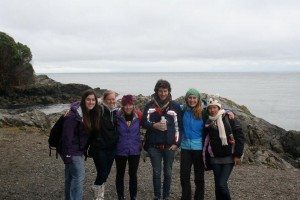
Read More
BLOG:
There is an old sailor tale that tells of a large ship one day caught in the middle of the Ocean. A large wave came over the side and knocked their anchor down into the depths of the ocean. No matter how much the sailors heaved and pulled they could not seem to pull up the anchor, and feared that if they pulled to hard they would make a hole in the bottom of the ocean, and drain out all the water. A brave sailor dove off the bow of the ship with knife in hand, ready to face whatever lay at the bottom of the sea. After a few tense minutes the sailor burst to the surface of the ocean and told the others that he had freed the anchor, and the ship was free to sail. After they had pulled him up onto the deck they asked him how he had freed the anchor. The sailor told them that a giant octopus had grabbed onto their anchor and was playing with it, but he had tied its legs into bowline knots, so it would never bother them again.
Although we didn’t encounter giant octopi on the Gato Verde (http://www.gatoverde.com/), I think this story reviles subtle truths about life out at Sea. First of all as a crew you have to be ready for anything whether it be a sea creature, or just the logistics of where to dock at night. Learning to be ready for anything at anytime takes a while to get use to, but like everything else we learned while on the Gato it seems to apply not only to sailing and science, to life.
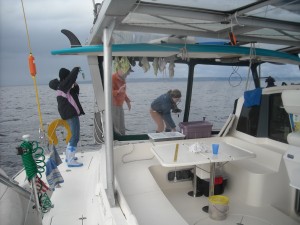
More Sailing!
One of the most important lessons I took away from the Gato was an understanding of what it takes to live sustainably. It is all too common to go through life unaware of the impact you are making, and the resources you are using. I feel that before my time on the Gato I was somewhat aware of my impact, and attempted to live sustainably, but I did not fully recognize the effect of everything I did. On the Gato we took measurements of the fresh water, sewage, and bio- diesel used. These are things that are easy to take for granted in every day life, but when living on a boat you start to realize just how much water you use, and sewage you produce. We had a water tank that held all our fresh water for dishes, drinking, and cooking with. Our water holding tank was on the port side of the Gato over the left hull. The water level was measured in cm and converted to liters and gallons. It was interesting to see how much water we used everyday. We still used a lot of water per person everyday, so it hard to imagine how much water we use daily when taking showers. The sewage tank was on the starboard side of the Gato near the bow. The sewage system was connected to the heads (bathrooms), which were on both the port and starboard side of the boat. Before the Gato I had not idea of how much sewage 8 people can produce, let alone a city, and how difficult sewage can be to deal with. Captain Todd explained the different types of holding tanks a boat can have, and the different ways to treat them. He had a type 3 system, which was an anaerobic system. He introduced a certain species of bacteria into his system that out competed the bacteria that make sewage smell. It was amazing to think that we had a tiny ecosystem on board the Gato with us. Who knew poop could be so fascinating!
In order to conserve bio-diesel we attempted to sail when the wind allowed. Although we didn’t get many opportunities to sail, it was a fun time when we did. Captain Todd taught us about the different points of sail: close-hauled, beam-reach, broad reach, running, and irons (no go zone). We got to steer the boat on our first cruse tacking down the Strait of Georgia. We learned how to sail right against the irons, without going into irons (60-50*) an ideal angle for sailing. We learned about how to let out the jib and main sail, and how to properly put both away.
As a class we also had to figure out our daily navigation. To do this we had to take a lot into consideration: the weather, sea state, tides, where the whales were, and where we would spend the night. At first this seemed to be a logistic nightmare, but after we created a routine for the navigator it became relatively easy. The hard part of navigating occurred when we had to make important decisions during the day, like if we were going to try and catch the whales.
Boat life is difficult, but extremely rewarding at the same time. Looking back my best memories of the boat involve sitting on the trampoline and just appreciating the sea that surrounded us.
Read More
Today is the last day of Beam Reach, and I don’t know how it went by so quickly. I came into this course ten weeks ago unaware of the amazing people I would meet, how much I would learn, and grow (unfortunately not height wise). So much has happened in ten weeks it’s difficult to sit down and distill it into words, but I will try. As class we were an unusual fit, we came in from completely different backgrounds, with different interests, from all over the world, but despite these differences we became inseparable.
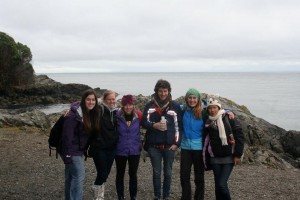 03 Skinny Love
03 Skinny Love
As time went on, and the class presented more challenges we never forgot to save time to laugh, and talk to one another. During stressful nights we would have the occasional dance party to help us get through our work in good spirits, but we also never forgot that we were at the labs to study whales.
The first time we encountered whales Robin, our lead professor, came running through the door of s1 out of breath to tell us their were whales in San Juan Channel. We dropped everything and ran as fast as we could down to the point to watch the whales. For many of us it was our first time seeing Orcas. It is an amazing feeling the first time you see a dark black fin slowly rising up out of the water. Its as if the whole world is centered on the magnificence and beauty of this one amazing animal. As the transients silently swam by it became clear to me at that moment why the work we did in this course mattered.
Since that first encounter with the whales I have never forgotten why I am here. I am sad that the course is coming to an end, but could not have asked for a better group of peers to spend the past 10 weeks with. They have inspired me to laugh, love, and learn everyday, and for that I am grateful.
Read More

on the boat
One of the more challenging aspects of living on a boat is having to cope with resource constrains, communication and mobility limitations. I don’t think I was fully prepared for this before I went on the boat. It only struck me after I had been on the boat for a few days that cell phone connection was intermittent in the Salish Sea, there was limited internet access, and we were not always docked.
This was not an easy lesson to learn and I realized that I had to think really far ahead in terms of planning my work. Although we generally had internet connection at Snug Harbor, the connection can get cut off when the boat moves, or sometimes even fail completely. I really had to budget my time and make full use of “internet timeâ€. Moreover, I could not rely on internet being available for the entire night.
Both Dr. Kodner and Dr. Buckman, our guest for two nights, were really helpful in helping me cope with this challenge. Most of the time, students use database (SQL) queries to filter and arrange data. This requires internet. When internet is not available, there is only Excel, which has a myriad of useful functions that make data analysis that much easier. Furthermore, Dr. Veirs has suggested that it’s possible to work with SQL as an offline application. That’s something!
Read More
I never thought I would be able to call the sea my home, but after living on a boat for an extended period of time, I can truly call myself a sailor, and a sustainable one at that! The Gato Verde is the only biodiesel electric commercial sailboat in the country, which makes it pretty darned special. It’s considered sustainable because of the myriad of things that keep the cat green, like being able to use the slightest touch of wind to power the boat. When the wind is lacking, the boat simply runs on electric power, and when electric power runs low, the boat is backed by biodiesel.
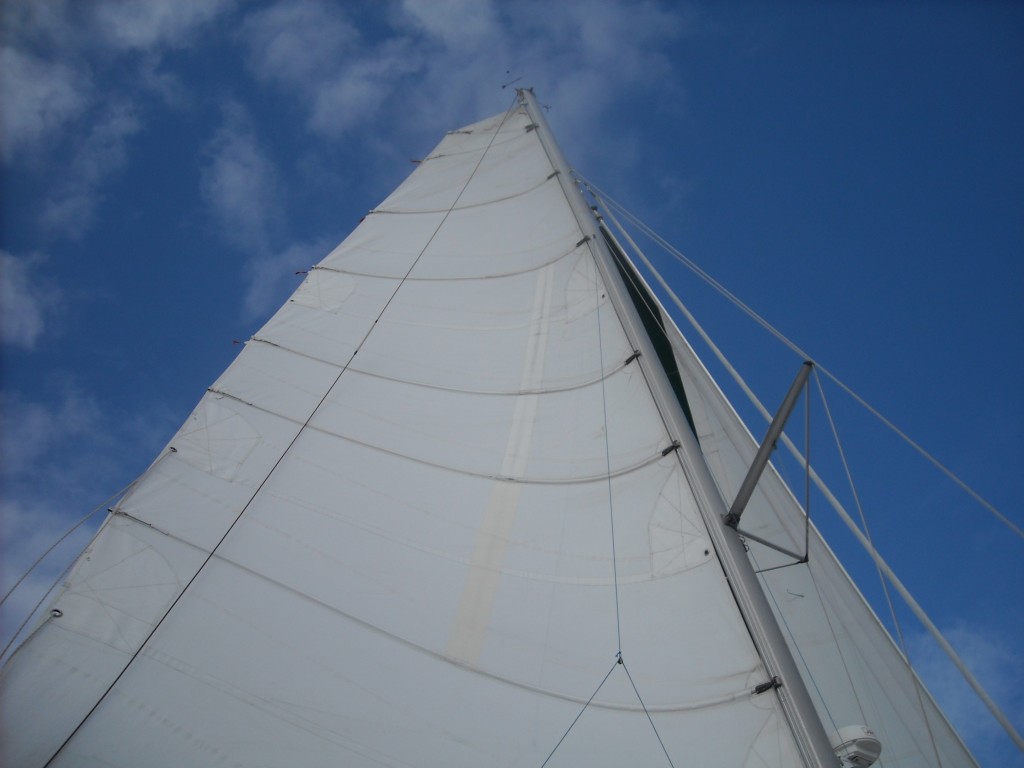
Sailing!
The electric power of the Gato is provided by heavy, lead acid batteries. These batteries are the same batteries that can be found in cars and their weight adds to the drag on the boat. In order to make the Gato more efficient and sustainable in the future, the type of battery used could be switched to lithium polymer batteries, which are lighter, more abuse tolerant, and could power the boat alone for a full four hours, as opposed to the current two hours that the lead acid batteries provide now. In addition to the battery type change, Captain Todd hopes to yet improve the sustainability of the Gato by converting the current black water system to a grey water system.
While we were out sailing through the Salish Sea, we had to constantly be conscious of our black water system. The black water system on the Gato Verde is the where the human waste is held, home to a unique ecosystem of hazardous pathogens, and it was how we kept our waste from entering the marine environment. We had two holding tanks on the boat, a primary and a secondary. When the primary holding tank was filled, it was pumped into the secondary holding tank and when both tanks were full, it was time to make a trip to pump out. We created a decent pump out rule, as pumping out is not always the most pleasant thing to do. The rule was that whoever did not pump out had to buy ice cream for whoever did pump out. Because of this, pumping out ended up being one of our favorite things to do on the boat! In addition to measuring the amount of waste produced, daily calculations were made of fresh water usage, biodiesel fuel, and power consumed.
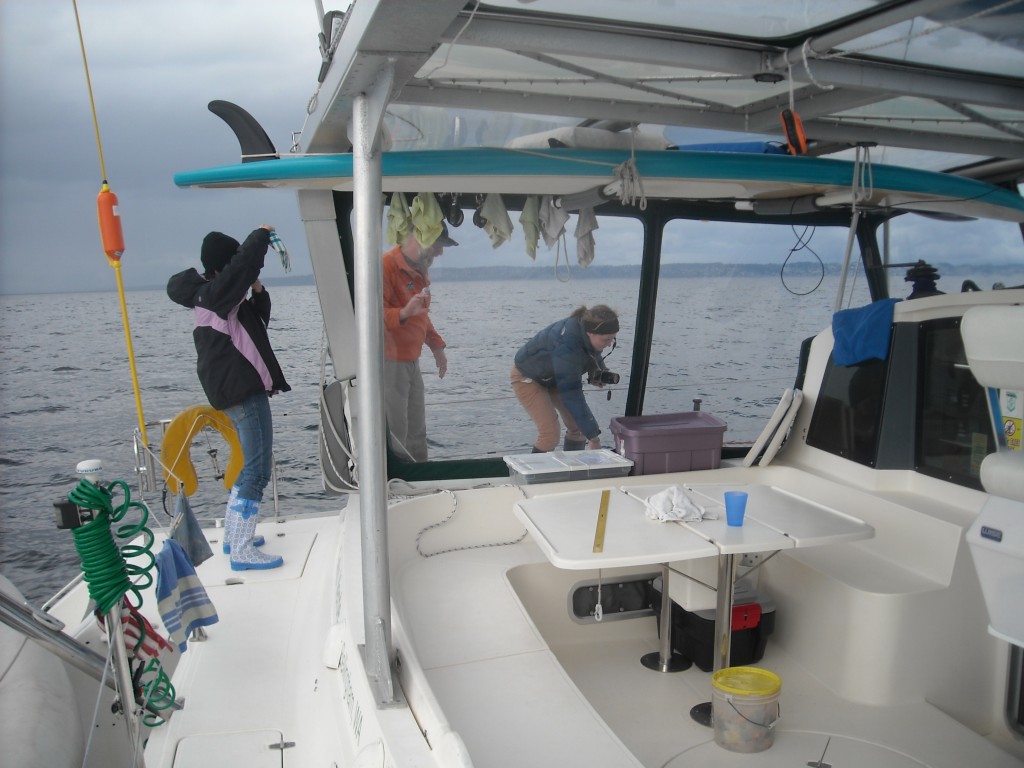
More Sailing!
When the environment permitted, we used it to maximize our efficiency. A few days out on the Gato allowed us to hoist the mainsail and test our skills at sailing. We used the wind to our advantage and optimized our angle with the wind, maneuvering the boat with the jib sheet by tacking. In addition to the different aspects of sailing, we learned a lot of other valuable information, like how to tie a double sheet bend knot, which is used to tie two lines together. My all time favorite knot was the bowline. I got so good at tying a bowline that at one point, I somehow managed to tie one single handed! Another knot I became very quick at tying, which I think is the most aesthetically pleasing knot of all, is the cleat hitch. The cleat hitch was used every time we docked instead of mooring or anchoring.
There were a number of tasks to accomplish when we anchored for the evening. To start, we lowered the anchor into the water. After the anchor was lowered, a bridle was put on the anchor chain to reduce the tension on it. We observed the angle of the anchor chain each time we anchored to be sure the anchor was secured at the sea floor.
One of my favorite things about sailing was the rare opportunity we had to view the southern resident killer whales from the water. As we approached the end of our voyage, we were all wondering when we would be able to see the greatly anticipated whales. Finally, three days before our trip ended they showed up and stayed in the Salish Sea long enough to be with them on each of our last days on the boat. Our last day, the whales were not very vocal, but they put on quite a show for us at East Point. We were running from port to starboard, shouting out behaviors like crazy! It was amazing to see how much of a mood booster the whales could be.
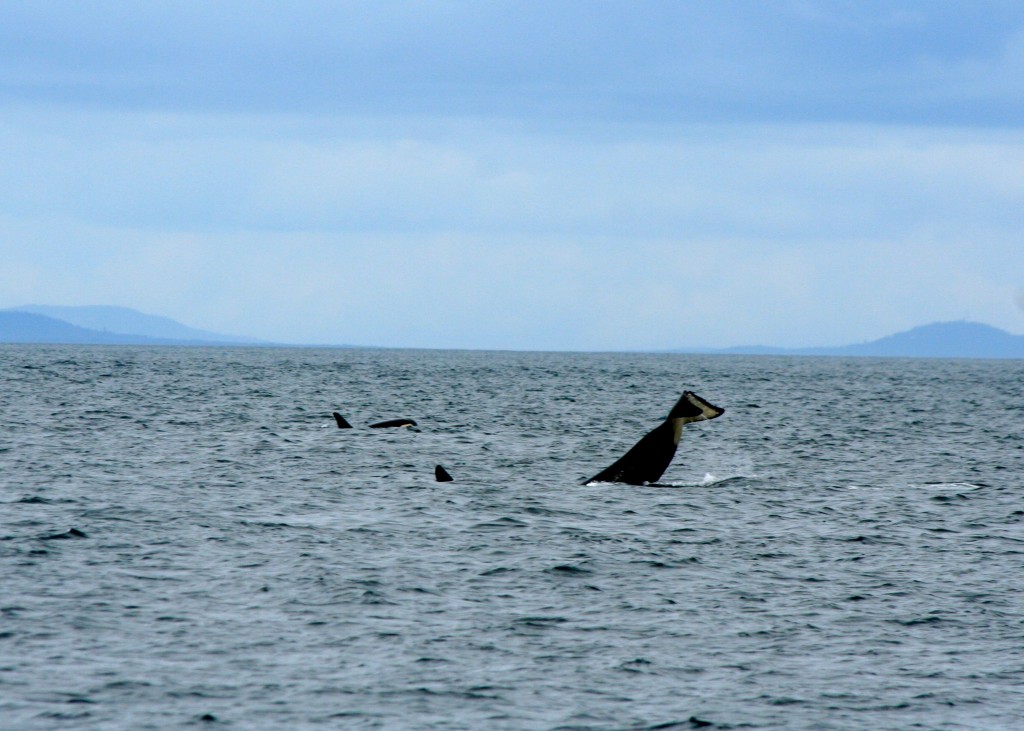
Killer whale tail slap, photo courtesy of myself (my pride and glory)
After a long, arduous, and exhausting week here at the Friday Harbor Labs, we have finally passed the threshold of our looming presentations. I will be sad to say goodbye, and while I know that I will never, ever forget the time I have spent here, it’s always difficult to leave a place where you feel so at home. This truly has been the experience of a lifetime. I have made lifelong friends and learned valuable skills and information that I will be able to use in almost every situation. Congratulations to the Beam Reach 121 class of spring 2012, you’ve done it!
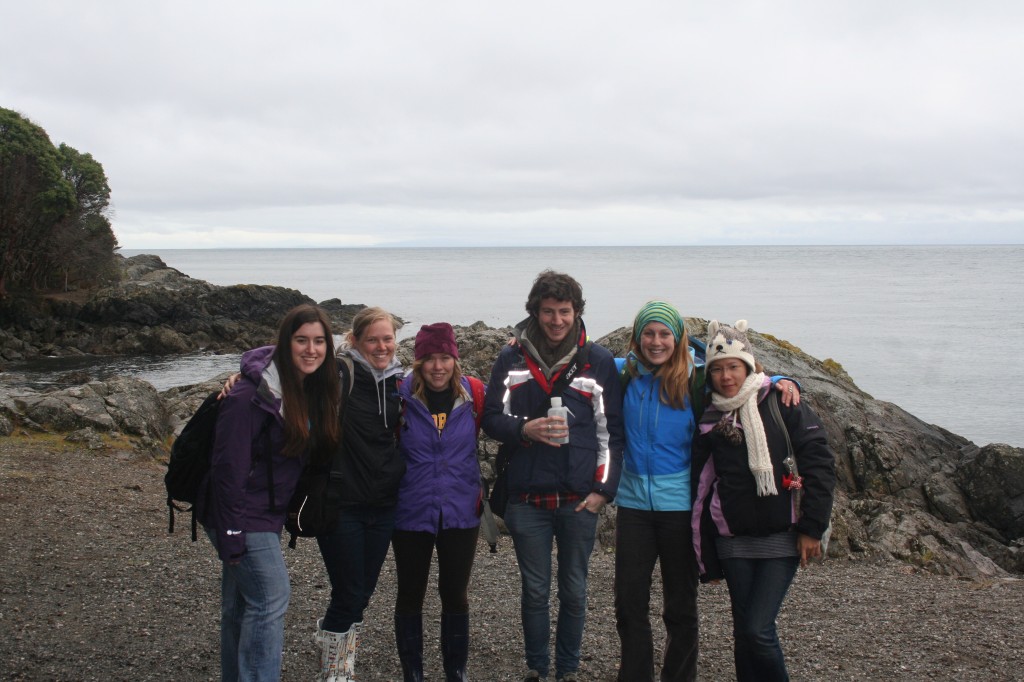
I love these guys!











 Twitter
Twitter LinkedIn
LinkedIn Facebook
Facebook